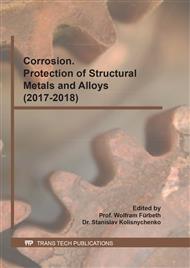p.79
p.84
p.88
p.96
p.101
p.107
p.113
p.119
p.125
Corrosion Behavior of Al-Zn-In Sacrificial Anode Alloys Produced by Conventional Casting and Semi-Solid Metal Casting Processes
Abstract:
A challenge in producing a sacrificial anode through conventional casting method is that the alloying elements in casting segregate during solidification, which further causes non-uniform anode corrosion reducing anode performance. In this paper, we investigated the performance of Al-5Zn-0.02In anode produced by conventional casting compared with by semi-solid casting technique. The performance of produced anodes were measured in terms of anode potential, current capacity, consumption rate and anode efficiency in 3.5% NaCl solution for 14 days. We found that the microstructure of the conventional cast anode had dendrites and coarse grains and the corrosion caused pitting corrosion. In contrast, the semi-solid cast anode had fine grains without any dendrites. The corrosion attacked mainly the grain boundaries and less on the matrix. Surprisingly, the conventional cast anode has about 10% higher efficiency than that of semi-solid cast anode.
Info:
Periodical:
Pages:
101-106
Citation:
Online since:
August 2017
Price:
Сopyright:
© 2017 Trans Tech Publications Ltd. All Rights Reserved
Share:
Citation:



